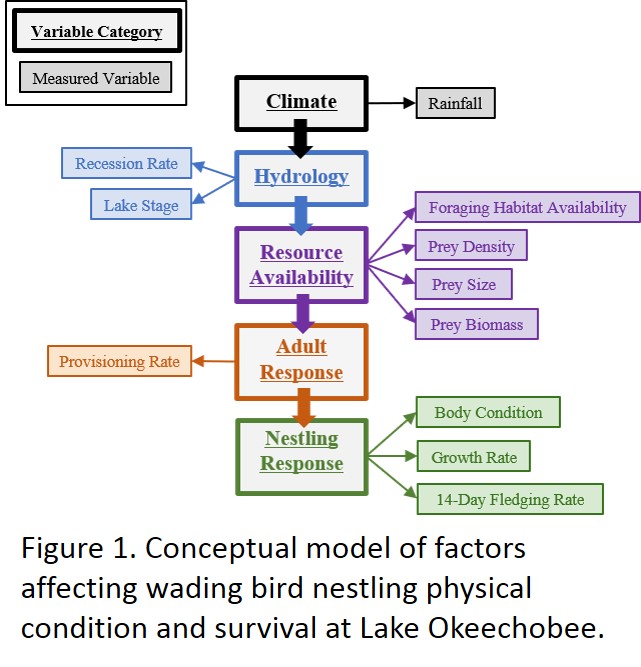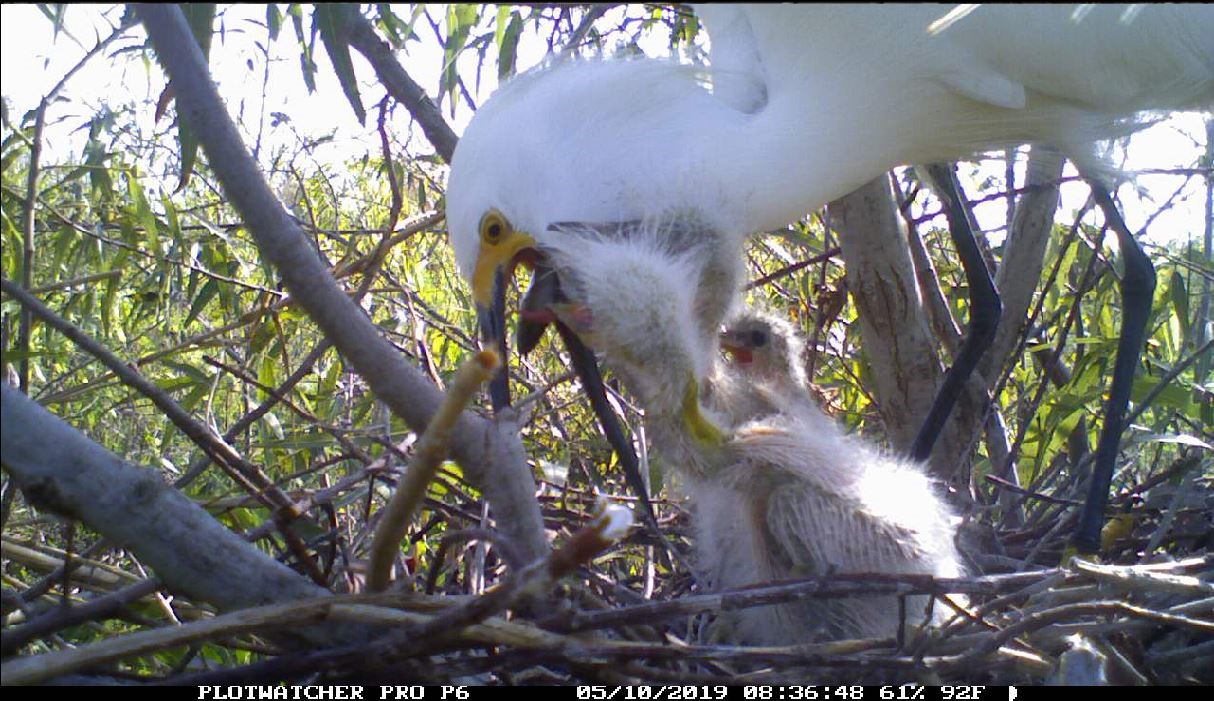
 The Comprehensive Everglades Restoration Plan (CERP), is a large, publicly-funded project meant to restore the hydrologic function of the south Florida watershed while also supplying water to the region’s human population. Thus, the success of CERP relies on the identification of hydrologic regimes that balance the requirements of a diverse group of stakeholders as well as ecosystem function. Due to the sensitivity of wetland species to hydrologic variation, the restoration of hydrologic patterns in the Greater Everglades ecosystem is predicted to have broad ecological impacts. To determine the effect of restoration activities on the overall health of the system, the CERP Monitoring and Assessment Plan (MAP) has established monitoring programs for indicator species, such as wading birds, that provide performance measures of restoration. Due to their high trophic position and reliance on particular hydrologic regimes, wading birds (Pelecaniformes and Ciconiiformes) are monitored globally as indicators of wetland ecosystem health. In the marshes of south Florida, hydrologic variation produces seasonal food pulses that are vital to wading bird reproduction. However, the mechanism by which food availability affects the species-specific reproductive success of wading birds is poorly understood. In particular, there has been little research on the effect of food availability on parental care activities (e.g. provisioning rates, incubation duration) in wading birds. In other avian species, breeding adults have been found to respond to changes in resource availability by altering nesting activity, foraging behavior, and parental care, which in turn affects the survival and fitness of nestlings.
The Comprehensive Everglades Restoration Plan (CERP), is a large, publicly-funded project meant to restore the hydrologic function of the south Florida watershed while also supplying water to the region’s human population. Thus, the success of CERP relies on the identification of hydrologic regimes that balance the requirements of a diverse group of stakeholders as well as ecosystem function. Due to the sensitivity of wetland species to hydrologic variation, the restoration of hydrologic patterns in the Greater Everglades ecosystem is predicted to have broad ecological impacts. To determine the effect of restoration activities on the overall health of the system, the CERP Monitoring and Assessment Plan (MAP) has established monitoring programs for indicator species, such as wading birds, that provide performance measures of restoration. Due to their high trophic position and reliance on particular hydrologic regimes, wading birds (Pelecaniformes and Ciconiiformes) are monitored globally as indicators of wetland ecosystem health. In the marshes of south Florida, hydrologic variation produces seasonal food pulses that are vital to wading bird reproduction. However, the mechanism by which food availability affects the species-specific reproductive success of wading birds is poorly understood. In particular, there has been little research on the effect of food availability on parental care activities (e.g. provisioning rates, incubation duration) in wading birds. In other avian species, breeding adults have been found to respond to changes in resource availability by altering nesting activity, foraging behavior, and parental care, which in turn affects the survival and fitness of nestlings.
 To investigate this mechanism, I will examine the relationship between resource availability, parental care, physical condition, and survival for two species of wading bird nestlings on Lake Okeechobee, a highly managed lake at the center of South Florida’s water control network (Figure 1). Quantifying the effect of variable resource availability on wading bird reproductive success will facilitate the management and restoration of highly managed lake-ecosystems through the identification of hydrologic regimes that consider species-specific ecological requirements. This is acutely important in a highly managed system, such as Lake Okeechobee. The aims of this study as are follows:
To investigate this mechanism, I will examine the relationship between resource availability, parental care, physical condition, and survival for two species of wading bird nestlings on Lake Okeechobee, a highly managed lake at the center of South Florida’s water control network (Figure 1). Quantifying the effect of variable resource availability on wading bird reproductive success will facilitate the management and restoration of highly managed lake-ecosystems through the identification of hydrologic regimes that consider species-specific ecological requirements. This is acutely important in a highly managed system, such as Lake Okeechobee. The aims of this study as are follows:
 I aim to determine the effect of prey and foraging habitat availability on nestling provisioning rates for two wading bird species that commonly breed on Lake Okeechobee, Snowy Egret (Egretta
thula, SNEG) and Tricolored Heron (
E. tricolor, TRHE). The results of this aim will add to our understanding of the species-specific responses of breeding wading birds to changes in foraging habitat conditions.
I aim to determine the effect of prey and foraging habitat availability on nestling provisioning rates for two wading bird species that commonly breed on Lake Okeechobee, Snowy Egret (Egretta
thula, SNEG) and Tricolored Heron (
E. tricolor, TRHE). The results of this aim will add to our understanding of the species-specific responses of breeding wading birds to changes in foraging habitat conditions.
 Morphometric measurements and 14-day fledging rates of monitored nestlings will be used to explore the effect of provisioning rates on nestling physical condition and survival for both wading bird species. The results of this aim will add to our understanding of how parental care affects the reproductive success of wading birds.
Morphometric measurements and 14-day fledging rates of monitored nestlings will be used to explore the effect of provisioning rates on nestling physical condition and survival for both wading bird species. The results of this aim will add to our understanding of how parental care affects the reproductive success of wading birds.